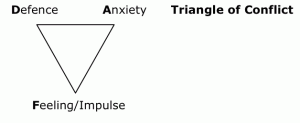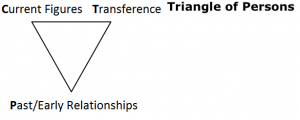Intensive Short-term Dynamic Psychotherapy (ISTDP) is an accelerated form of psychodynamic psychotherapy designed to provide rapid access to the unconscious. It was developed by Dr Habib Davanloo, a psychiatrist from Montreal who grew frustrated with the length and unreliability of psychoanalysis. Refined through empirical, video-recorded research, ISTDP is more active and focussed than traditional psychodynamic psychotherapy. It has been shown to be effective in the treatment of anxiety, depression, character disorders (referred to as personality disorders in DSM) and somatisation. It aims to provide not only symptom relief, but also personality restructuring.
The metapsychology of ISTDP makes use of the two triangles which succinctly summarise basic psychodynamic concepts.


Feelings and impulses that early caregivers did not tolerate, evoke anxiety and are avoided by the use of defenses. As illustrated by Malan’s (1979) Triangle of the Person, core emotional conflicts from the patient’s early relationships are re-enacted with others in the patient’s current life, including the therapist.
Like any dynamic treatment, faulty cognitions are not viewed as an end in themselves as they are in cognitive-behavioural therapy (CBT), but as defenses against unconscious feelings and anxiety. If the defenses work well, little or no anxiety is experienced. If the defenses fail in keeping the feelings well-hidden, anxiety rises at the prospect of the feelings rising to the surface.
Gentle but persistent pressure is exerted on the patient, to acknowledge and turn against the defenses that block the experience of the true feelings. Once defenses are removed, the patient experiences the intense, mixed memories and feelings. As research attests, it is not considered sufficient to have insight into our true feelings; the direct experience of the feelings about the past and the present, during the therapy session, is essential to extinguish their power to produce anxiety and to render the defenses redundant.
Any anxiety evoked during this process is directly addressed so that it does not become overwhelming.
With ISTDP it is possible to break through lifelong defenses within a single session, thus “unlocking” the patient’s unconscious and providing direct access to the patient’s past.
We seek that each individual should become authentic and whole, able to fully engage and participate in life without being hampered by painful emotions and maladaptive ways of relating and behaving. Improvements in well-being and functioning generally continue beyond the end of the therapy.
It is a treatment model that is consistent with the latest neuroscientific evidence on how the adult brain changes.
